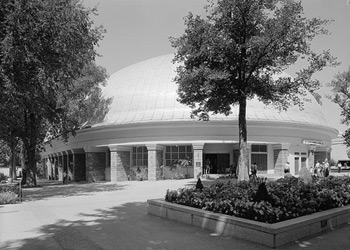Salt Lake Tabernacle, Salt Lake City, Utah, USA

Photo courtesy of the Library of Congress,
Prints & Photographs Division
The Salt Lake Tabernacle, located on Temple Square, was built under the direction of President Brigham Young between the years 1863 and 1867, and has served as the home of the world-renowned Mormon Tabernacle Choir since its completion.
To construct a building the size of the tabernacle was an impressive feat at that time because of the difficulty in transporting building materials without the use of railroads. William H. Folsom, the LDS Church Architect, created the preliminary plans for the tabernacle and the cornerstone was laid on July 25, 1864.1 Red sandstone blocks were quarried from the Red Butte Canyon east of Salt Lake City and used to support the large elliptical dome.2
Henry Grow, an experienced bridge builder, was appointed to direct the construction of the tabernacle. Grow constructed large trusses spanning the entire 150-foot width of the building that enabled the structure to stand without intermediate support and helped create the acoustically perfect interior. At the time of its construction, it was believed to be the largest building in the world unsupported by columns. Truman O. Angell was appointed Church architect in 1867 and designed the interior.
In 1869-70, a balcony was added significantly increasing the seating capacity to approximately 10,000, as well as improving the acoustics.
Joseph Ridges, a carpenter and cabinet maker designed and constructed the tabernacle’s organ. Initially, the organ required five men operating hand-pumped bellows in order to provide the wind required to play it. The hand-bellows were subsequently replaced by a water-powered mechanism and later an electronic device provided the necessary wind.3 The organ currently contains 11,623 pipes, making it one of the largest organs in the world.
The tabernacle also served as the location for the semiannual General Conference sessions of the of The Church of Jesus Christ of Latter-day Saints between 1867 and 1999 after which time the conferences were moved to the the newly constructed Conference Center north of Temple Square.
The Salt Lake Tabernacle stands today as a testament to the determination and ingenuity of the early pioneers who settled the Salt Lake Valley.
SOURCES
1 Paul L. Anderson, “Tabernacle, Salt Lake City, Utah,” Encyclopedia of Mormonism, 1-4 vols., edited by Daniel H. Ludlow [New York: Macmillan, 1992], 1434.
2 Howard W. Hunter, “The Tabernacle,” Ensign, November 1975, 94.
3 John Longhurst, “I Have a Question,” Ensign, February 1984, 29.
Map & Directions
Hours of Operation : Monday – Saturday, 9 AM – 9 PM
Phone Number: (801) 240-4872
Admission: Free
Articles & Resources
Paul L. Anderson, “Tabernacle, Salt Lake City, Utah,” Encyclopedia of Mormonism, 1-4 vols., edited by Daniel H. Ludlow [New York: Macmillan, 1992], 1434.
George E. Carpenter, “Men Who Have Done Things: Joseph H. Ridges, The Man Who Built the Tabernacle Organ,” The Western Monthly, 1911.
Kate B. Carter, comp., “The Great Mormon Tabernacle,” Our Pioneer Heritage, 1968.
Stewart L. Grow, A Tabernacle in the Desert, 1958.
Stewart L. Grow, “Bring on the Lumber: The Building of the Tabernacle,” Improvement Era, 1967.
Gordon B. Hinckley, “Building Your Tabernacle,” Ensign, November 1992, 50.
Howard W. Hunter, “The Tabernacle,” Ensign, November 1975, 94.
John Longhurst, “I Have a Question,” Ensign, February 1984, 29.
Robert C. Mitchell, “Desert Tortoise: The Mormon Tabernacle on Temple Square,” Utah Historical Quarterly, 1967.
Levi Edgar Young, The Great Mormon Tabernacle with its World-Famed Organ and Choir, 1917.
Albert L. Zobell, Jr., “Opening of the Tabernacle,” Improvement Era, 1967.
